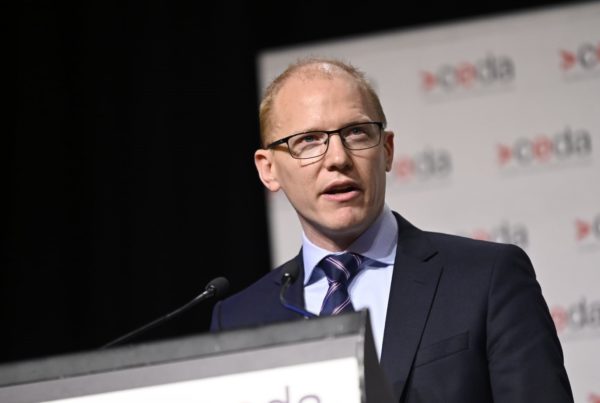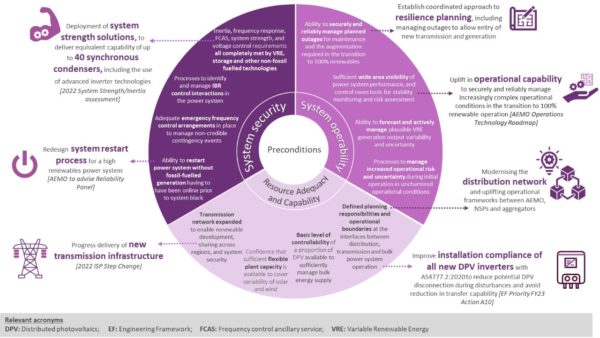As Australia’s power system transitions from centralised generation to a decentralised system, the Australian Energy Market Operator (AEMO) has published its latest assessment of what is required to ensure the National Electricity Market (NEM) can securely and reliably operate at 100% instantaneous renewable penetration for the first time by as early as 2025.
The Engineering Roadmap to 100% Renewables report provides an overview of the technical, engineering, and operational challenges and actions needed to enable Australia’s main interconnected power system to operate solely on renewable generation including grid-scale wind and solar, pumped hydro, storage, and rooftop PV.
AEMO said the increasing proportion of renewable energy generation in the NEM, alongside the decommissioning of fossil-fuel generation, is leading to a “once-in-a-lifetime change” in the way the energy system is designed and operated.
AEMO Chief Executive Daniel Westerman said Australia’s NEM will rapidly cross uncharted operational conditions yet to be experienced here or in comparable power systems internationally.
“Operating a gigawatt-scale power system at 100% instantaneous renewable generation is a feat unparalleled worldwide,” he said.
AEMO said to satisfy more regular operation at 100% renewable penetration, the power system will require additional engineering solutions to provide essential system services to maintain a stable electrical voltage and frequency and ensure a secure state of operation. Proven technologies such as synchronous condensers will play a role, alongside newer technologies such as grid-forming inverters.

Image: CEDA
The Australian government is targeting 82% of energy in the NEM from renewable sources by the end of the decade as part of its legislated target of a 43% reduction in 2005-level emissions by 2030 and net-zero emissions by 2050.
Modelling conducted by AEMO indicates Australia’s main grid could reach 100% instantaneous renewables by as early as 2025, initially for a half-hour period but eventually the periods of operating entirely on renewables will become more frequent and longer in duration over subsequent years.
Westerman said it is critical to prepare for the first instance of any new operational condition in advance of that condition arising, and preparing for that first instance often also enables the system to operate under that condition on a regular basis
“Australia is transitioning from a historic dependency on coal generation to higher levels of renewable energy, supported by firming technologies, like pumped hydro, batteries and gas generation, and transmission developments to share low-cost sources of energy to our towns and cities,” he said.
“Complementing these investments is the shared responsibility to also re-engineer the power system to run reliably and securely on higher levels of renewable energy.
“Being ready to operate the power system with high penetration levels of renewables is critical to ensure a smooth energy transition, meet Australia’s emission reduction commitments and ensure reliable, secure and affordable energy for consumers into the future.”
While the report is focused on the NEM, the roadmap is intended to deliver national benefits, with learnings applied to Western Australia’s South West Interconnected System (SWIS) and Wholesale Electricity Market (WEM).

The roadmap is divided into three broad technical themes – power system security, system operability and resource adequacy – with associated preconditions and actions to operate the NEM for periods of up to 100% renewable generation.
Westerman said the roadmap provides a clear view of the urgent engineering and operational steps required to be ready to leverage the benefits of high renewable generation levels.
This includes investigating new sources of firming capacity, system restoration, and system strength services, including energy storage. Initial analysis indicates the equivalent of up to 40 large synchronous condensers may be needed for 100% renewable penetration, potentially provided by a range of technologies.
“Importantly, further work will be needed to ensure that any investment decisions to deliver the engineering requirements are made in the long-term interests of consumers, and underpinned by efficient regulatory and market solutions,” Westerman said.
AEMO will host a webinar on 3 February 2023 providing interested stakeholders with an overview of the Engineering Roadmap to 100% Renewables, along with an opportunity to ask questions of the report’s authors.
This content is protected by copyright and may not be reused. If you want to cooperate with us and would like to reuse some of our content, please contact: editors@pv-magazine.com.



